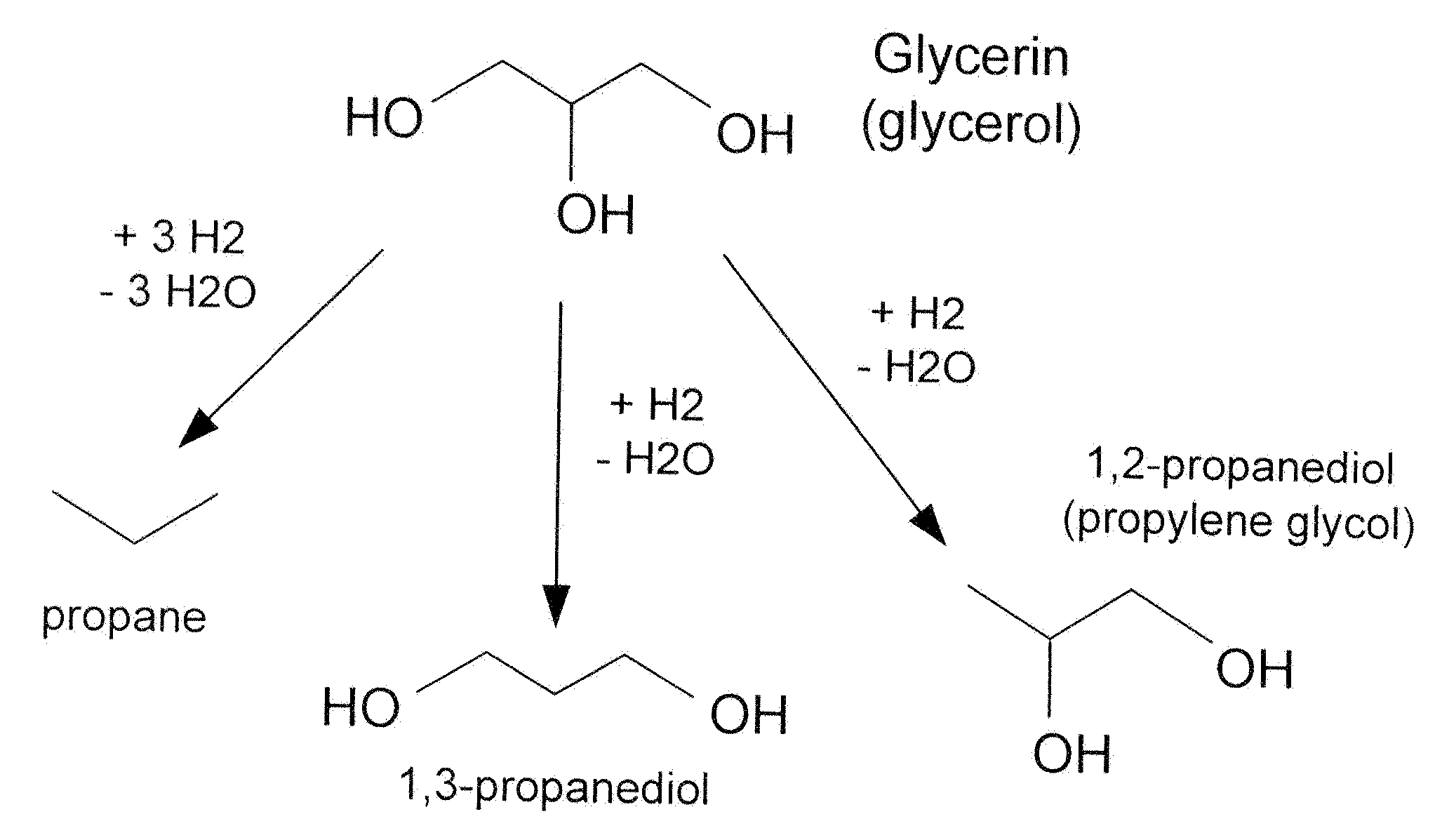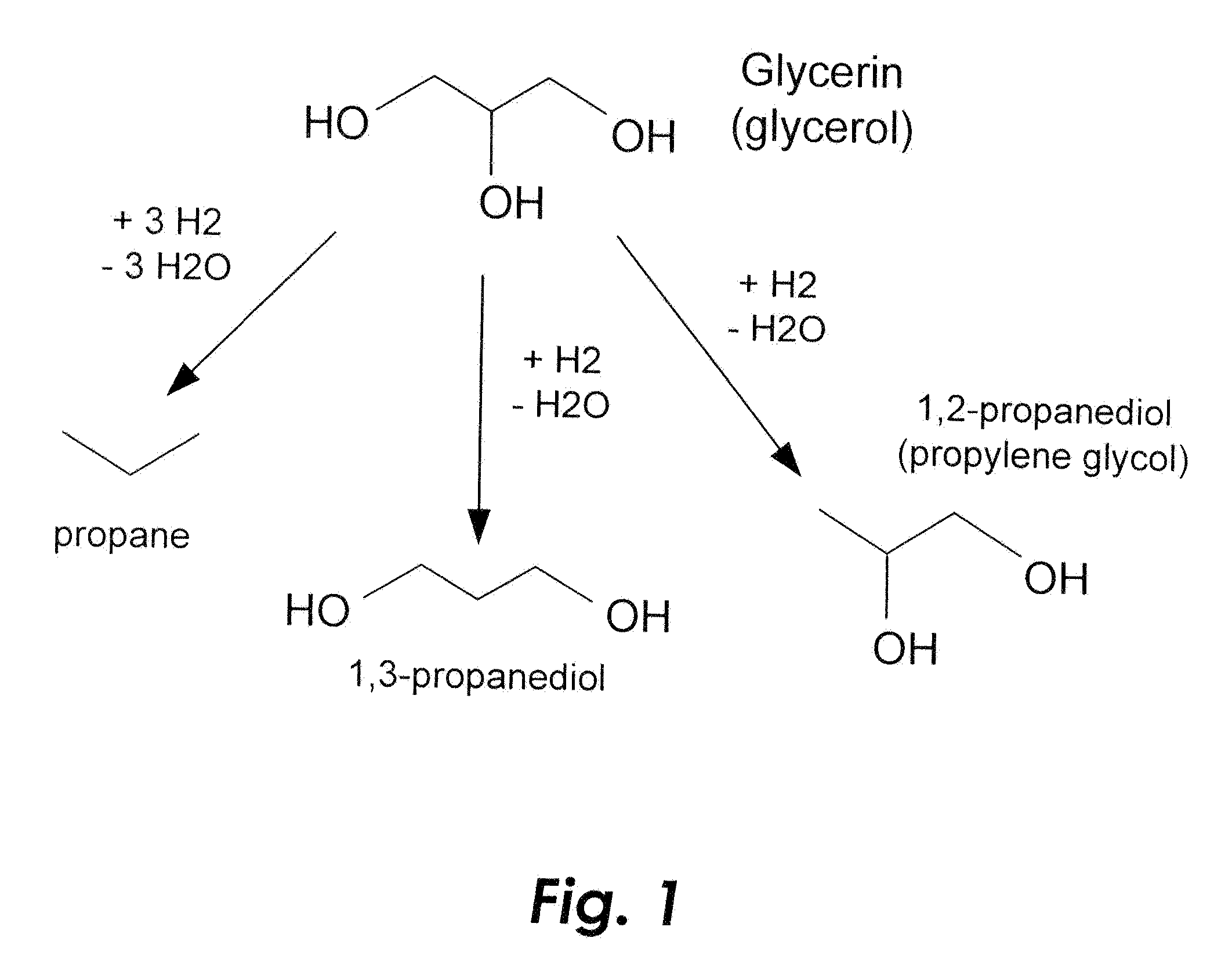Flexible glycerol conversion process
- Summary
- Abstract
- Description
- Claims
- Application Information
AI Technical Summary
Benefits of technology
Problems solved by technology
Method used
Image
Examples
example 1
Complete Conversion of Glycerol to Propane Synfuel was Successfully Demonstrated in a Pilot Study
[0017]To assess the feasibility of converting glycerol into propane using a process of catalytic conversion, a pilot study was conducted using a pilot scale tubular reactor. The reactor was loaded with 80 cubic centimeters of high macro-pore (34% of pores>100 Å) nickel-tungsten catalyst. The catalyst was sulfided to further modify the catalyst, and the reactor was started up in trickle-bed mode using a feedstock of 98% pure glycerol (Sigma-Aldrich, St. Louis, Mo.). Glycerol was supplied to the reactor at a flow rate of 0.65 LHSV, and hydrogen was supplied to the reactor at a pressure of 2,200 psig and at a flow rate of 20,000 scf / bbl. The operating temperature of the reactor during this experiment was set at 650° F. Gas phase products were collected and analyzed using an online gas chromatography instrument, and the resulting liquid phase products were also collected and analyzed using g...
example 2
The Conversion of Glycerol to Propane Synfuel was Sensitive to the Metals Contained in the Catalyst Used in the Reactor
[0019]To assess the effect of the composition of the catalyst on the process of converting glycerol into propane, a study was conducted using a pilot scale tubular reactor. The reactor was loaded with 80 cubic centimeters of nickel molybdenum catalyst. The catalyst was sulfided to further modify the catalyst, and the reactor was started up in the trickle-bed mode using a feedstock of 98% pure glycerol (Sigma-Aldrich, St. Louis, Mo.). Glycerol was supplied to the reactor at a flow rate of 0.65 LHSV, and hydrogen was supplied to the reactor at a pressure of 2,200 psig and at a flow rate of 20,000 scf / bbl. The operating temperature of the reactor during this experiment was set at 650° F. The gas phase product was analyzed using an online gas chromatography instrument, and the resulting liquid phase products were also collected and analyzed using gas chromatography-mass...
example 3
The Catalytic Conversion of Glycerol to Propane Synfuel is not Sensitive to the Surface Texture of the Catalyst
[0021]To assess the sensitivity of converting glycerol into propane synfuel using catalytic hydrogenation to the density of pores on the surface of the catalyst, a study was conducted using a pilot scale tubular reactor. The reactor was loaded with 80 cubic centimeters of low pore nickel-tungsten catalyst. The catalyst was sulfided to further modify the catalyst, and the reactor was started up in the trickle-bed mode using a feedstock of 98% pure glycerol (Sigma-Aldrich, St. Louis, Mo.). Glycerol was supplied to the reactor at a flow rate of 0.65 LHSV, and hydrogen was supplied to the reactor at a pressure of 2,200 psig and at a flow rate of 20,000 scf / bbl. The operating temperature of the reactor during this experiment was set at 650° F. Gas phase products were collected and analyzed using an online gas chromatography instrument, and the resulting liquid phase products wer...
PUM
| Property | Measurement | Unit |
|---|---|---|
| Temperature | aaaaa | aaaaa |
| Surface | aaaaa | aaaaa |
| Macropore | aaaaa | aaaaa |
Abstract
Description
Claims
Application Information
 Login to View More
Login to View More - R&D
- Intellectual Property
- Life Sciences
- Materials
- Tech Scout
- Unparalleled Data Quality
- Higher Quality Content
- 60% Fewer Hallucinations
Browse by: Latest US Patents, China's latest patents, Technical Efficacy Thesaurus, Application Domain, Technology Topic, Popular Technical Reports.
© 2025 PatSnap. All rights reserved.Legal|Privacy policy|Modern Slavery Act Transparency Statement|Sitemap|About US| Contact US: help@patsnap.com


